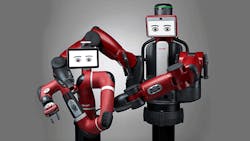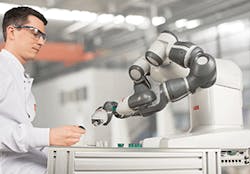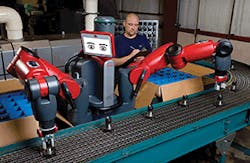Behind the doors of a regular factory making regular things, human workers unload parts into the hands of robots.
There are no gates, no light curtains to protect man from machine, just robots working side-by-side with humans.
The robots take those parts and combine them midair, their mechanical arms twisting just so with the precision only machines know, before handing the parts off to other robots, which link other pieces as they fly across the factory floor. And so on down the line.
These synchronized collaborative robots perform a mechanical dance of sorts on the factory floor. They take the concept of the traditional conveyor belt and twist it into something even more automated, something futuristic.
"The robots were flowing the parts down the line," recalled George Schuster, functional safety expert for Rockwell Automation. "It was a jaw-dropper for me."
And Rockwell Automation built that robotic masterpiece, an idea borne by a customer seeking a large robotic system.
This large-scale automation not only is possible, but probable as robots and humans work ever closer together.
"The factory of the future, it's happening today," said Matt Dodds, product marketing manager of safety vision, controllers, edges and mats for Omron Automation and Safety.
Collaborative robots are changing the game in industry, creating new opportunities as the walls dividing man and machine are dismantled.
But as those barricades disappear, the protections need to become more nuanced. Safety becomes a pre-engineered solution rather than a physical barrier.
Safety without Borders
Roberta Nelson Shea, global marketing manager of safety components for Rockwell Automation, identifies four characteristics that – in whole or in part – define a robot that can be used in a collaborative application. That is, as a machine that can work alongside a human without traditional safeguards.
Safety-rated monitored stop: The robot is able through its safety system to perform a protective stop that is safety-rated and monitored. This enables human workers to hand parts directly to the end effector – the device at the end of a robotic arm, essentially the hand of the robot.This feature, in various forms, has been used in industrial applications for more than 10 years, and was present in the hundreds of robots installed by ABB Inc. in the mid-2000s at an automotive assembly plant. Whereas those robots were managed by external means, today's robots now use internal monitoring by the robot safety control system.
Hand-guiding operation: This feature allows operators to manually control and enable robot movement while it is in automatic mode. The robot's speed is reduced and it can make safety-rated monitored stops, allowing an operator to move a robot to another position or location."This puts operators in direct contact with a robot system," Nelson Shea said. "However, this emerging technology has not seen wide adoption as there remain challenges for both manufacturing and safety engineering teams."
Speed and separation monitoring:Using sensors, a robot maintains the needed distance from an operator, meaning it reduces its speed and comes to a protective stop (safety-rated monitored stop) before the robot system can make contact with the operator.The next iteration of this ability will be to develop a safeguarding device that's integrated with the safe motion control, which would redirect the robot system away from intruders, Nelson Shea said.
"It's defensive. The robot tries to keep away," she said. "Think of it as this: A person dancing with a robot. You take a step forward. It goes back. You take a step back, it comes forward. You do a rapid approach, it does a quick slow down to a protective stop."
This capability doesn't yet exist, but seems to be the inevitable next stop, according to Nelson Shea.
Power and force limiting: The robot is limited in speed and force so that incidental contact – either by the robot, the end effector or the part – will not harm the person.This attribute, while seemingly the seminal concern when it comes to collaborative robots, also is the most challenging.
"There wasn't a lot to go by to understand what it takes to harm a person. Most studies of human physiology are cruder. You know what force it takes to break a bone. You know what force it takes to break a skull," Nelson Shea said.
But figuring out how to ensure someone doesn't experience any pain involved studying a lot of factors, including age and health condition.
"It's not just the notion of ‘do not break and maim,'" she said. "We want there to be no pain."
And this becomes even more complicated when you consider all of the different applications a robot might have throughout the factory, making the need for safety professionals and production workers to communicate paramount.
Back to the Basics
Despite all of these safety features with which today's robots are equipped, it takes more to truly make a robot collaborative.
"There is this misunderstanding that a robot is collaborative by itself," Omron's Dodds said.
But really, a robot is only one part of a collaborative work environment.
"A collaborative robot is but one component of a collaborative robot system," said Schuster. "It is impossible to evaluate the efficacy or the hazards or the potential harm to a person without considering the collaborative robot in a very systemic way."
And that means returning to the basics.
Before bringing robots into a workplace, safety personnel need to complete thorough risk assessments to determine exactly what could happen and safeguard against it.
But this is no easy task. Robots are designed to be repurposed around the plant quickly and easily, making risk assessments a challenge.
Basically, safety professionals need to treat robots like any other part of operations and perform due diligence on speed, motion, tasks and so on.
And this is where the disconnect exists: those responsible for safety on the robotics side of the aisle and those in charge of safety on the industrial side need to communicate better. Collaborative robot safety still is a new and evolving field, one with new standards and fuzzy understandings.
"Industry needs you," he said to the crowd of safety professionals and robotics engineers. "If you see a safety guy, teach him. We need someone we can trust."
Dupont highlighted the struggle safety managers have in not only having to understand these complex new machines, but also how to bring these machines into the factory while keeping employees safe.
"Help us! Help industry to protect the employees who work with their hands every day!" he said.
But thankfully, it seems that tide is changing, according to Dodds.
"The biggest reward I see now is a lot more people asking for help," he said.
About the Author
Ginger Christ
Associate Editor
Ginger Christ is an associate editor for EHS Today, a Penton publication.
She has covered business news for the past seven years, working at daily and weekly newspapers and magazines in Ohio, including the Dayton Business Journal and Crain’s Cleveland Business.
Most recently, she covered transportation and leadership for IndustryWeek, a sister publication to EHS Today.
She holds a bachelor of arts in English and in Film Studies from the University of Pittsburgh.


